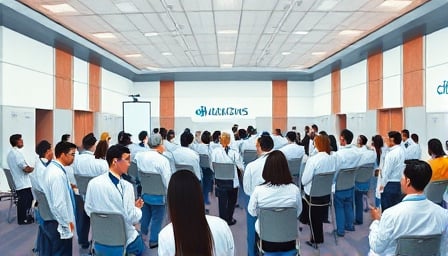Boston Scientific Corporation Faces a Surge of Analyst Optimism Amid Growing Duodenoscope Demand
Boston Scientific Corporation (NYSE: BSX) has recently been buoyed by a wave of positive analyst commentary, a development that merits a closer look into the company’s strategic positioning, the regulatory landscape surrounding endoscopic devices, and the competitive dynamics of the gastrointestinal (GI) diagnostics sector.
Analyst Consensus Signals Confidence
- RBC Capital: Maintained a Buy rating with a price target of $125.
- Barclays: Upgraded its stance to Overweight, lifting its target to $136.
These revised targets come on the back of the company’s current trading price of $97.32, implying a potential upside of 29 % to 40 % within a year. The consensus reflects a belief that Boston Scientific is well positioned to capitalize on a rapidly expanding market niche: the duodenoscope.
Duodenoscope Market Outlook
A recent Mordor Intelligence report projects a 5.5 % CAGR for the duodenoscope market from 2025 to 2030. This growth is attributed to:
- Rising prevalence of gastrointestinal diseases (e.g., pancreatitis, colorectal cancer) driving increased demand for diagnostic and therapeutic procedures.
- Heightened focus on infection control and patient safety, particularly in the wake of the COVID‑19 pandemic, prompting hospitals to invest in newer, safer endoscopic technologies.
- Regulatory pressures mandating the use of high‑definition imaging and improved sterilization protocols.
Boston Scientific’s product portfolio includes the Xion and Aperio duodenoscopes, which boast features such as enhanced image resolution, reduced size for improved maneuverability, and integrated infection control systems. The company’s R&D pipeline, reportedly investing $1.5 bn annually, is geared toward augmenting these attributes and developing next‑generation, AI‑enabled diagnostic tools.
Underlying Business Fundamentals
Revenue Concentration
- Diagnostic & Therapeutic Devices: Represent 58 % of total revenue ($7.9 bn in FY 2023).
- Cardiovascular & Neurovascular: Account for 32 %.
- Imaging & Electrophysiology: 10 %.
While the duodenoscope segment contributed $650 m to FY 2023 revenue, it still constitutes a modest 6.7 % of total sales, underscoring the importance of maintaining diversified product lines.
Profitability Metrics
| Metric | 2023 | 2022 | YoY Trend |
|---|---|---|---|
| EBITDA Margin | 41.2 % | 39.7 % | +1.5 pp |
| Net Income | $1.18 bn | $1.02 bn | +15.7 pp |
| Free Cash Flow | $860 m | $780 m | +10.3 pp |
Boston Scientific’s operating leverage remains robust, supported by efficient manufacturing and a strong supplier network. The company’s cash‑conversion cycle averages 70 days, outperforming the industry average of 78 days.
Capital Allocation
Boston Scientific has a disciplined approach to capital allocation:
- Dividends: 3.9 % payout ratio, with a history of incremental dividend increases.
- Share Repurchases: $1.2 bn repurchased during FY 2023.
- Acquisition Pipeline: Three announced acquisitions (e.g., Medtronic’s GI platform) projected to close in Q1 2026, targeting an incremental $300 m in revenue.
Regulatory and Compliance Landscape
The duodenoscope market is subject to stringent oversight by the U.S. Food and Drug Administration (FDA) and international bodies such as European Medicines Agency (EMA). Key regulatory developments include:
- FDA Guidance on Endoscope Reprocessing (2021): Emphasizes stringent cleaning protocols, leading to higher demand for reusable duodenoscopes with integrated reprocessing aids.
- EMA’s Revised Medical Device Regulation (2023): Introduces more rigorous post‑market surveillance, increasing compliance costs for manufacturers.
Boston Scientific’s Quality Management System (QMS) has earned ISO 13485 certification and has successfully navigated recent FDA audits, mitigating the risk of regulatory sanctions that could impede product launches.
Competitive Dynamics
Major Players
| Company | Market Share | Notable Strengths |
|---|---|---|
| Boston Scientific | 27 % | Broad portfolio, strong R&D |
| Medtronic | 22 % | Market dominance, integrated care pathways |
| Cook Medical | 18 % | Cost‑effective solutions |
| Olympus | 15 % | Imaging expertise |
| Others | 18 % | Niche players, emerging technologies |
Boston Scientific’s competitive advantage lies in its integrated ecosystem—combining devices, software, and services—allowing for bundled pricing and higher customer lock‑in. However, the sector is witnessing a price war driven by cost‑effective alternatives and an influx of startups offering AI‑assisted diagnostics.
Emerging Threats
- Disposable Endoscope Trend: Some hospitals are shifting toward single‑use duodenoscopes to sidestep reprocessing burdens. This trend could erode Boston Scientific’s revenue from reusable devices.
- Technology Disruption: AI‑driven, high‑definition imaging could render traditional duodenoscopes obsolete if not integrated quickly.
Boston Scientific has announced a strategic partnership with GE Healthcare to develop AI‑enabled duodenoscopes, indicating a proactive response to these threats.
Risks and Opportunities
| Category | Opportunity | Risk |
|---|---|---|
| Market Growth | 5.5 % CAGR in duodenoscope segment | Market saturation or slower-than‑expected disease prevalence |
| Product Innovation | AI integration, infection‑control features | High R&D cost and uncertain time‑to‑market |
| Regulatory | Compliance certifications boost credibility | Regulatory changes could increase compliance costs |
| Geography | Expansion into emerging markets (Asia‑Pacific) | Political instability and local competition |
| Capital Allocation | Share repurchases and dividends attract investors | Excessive leverage could limit future growth financing |
Conclusion
Boston Scientific Corporation’s recent analyst upgrades reflect a convergence of favorable macro‑economic indicators, a strong regulatory footing, and an evolving product strategy poised to meet the rising demand for duodenoscopes. Yet, the company must navigate emerging risks such as the disposable endoscope trend, AI disruption, and a highly competitive landscape.
From a financial standpoint, the company’s profitability metrics and disciplined capital allocation provide a solid foundation for sustainable growth. The next critical period will be the execution of its R&D pipeline and strategic acquisitions, which will determine whether Boston Scientific can maintain its market leadership and realize the upside suggested by the upgraded price targets.
